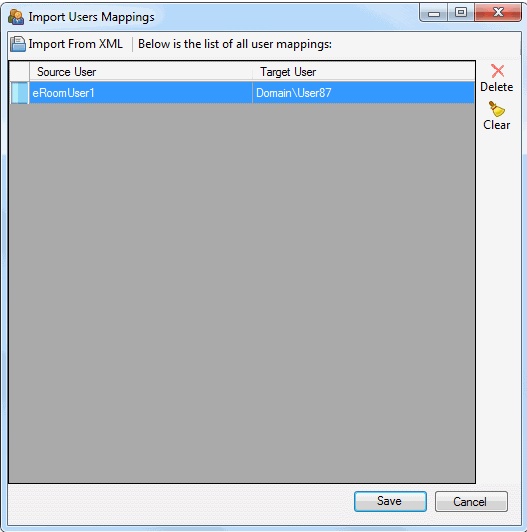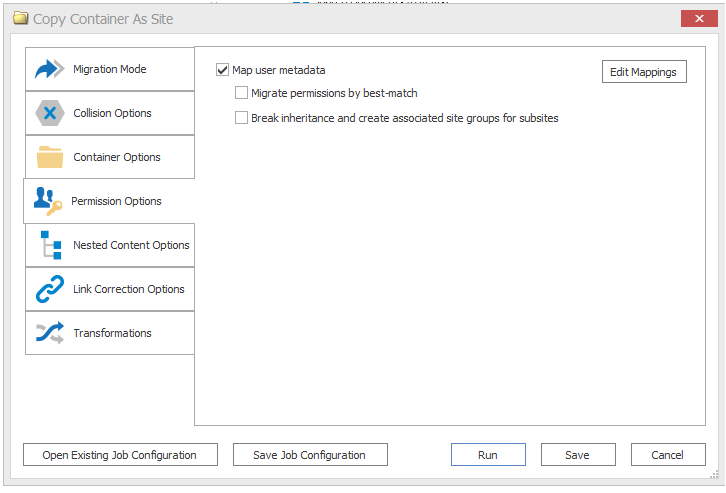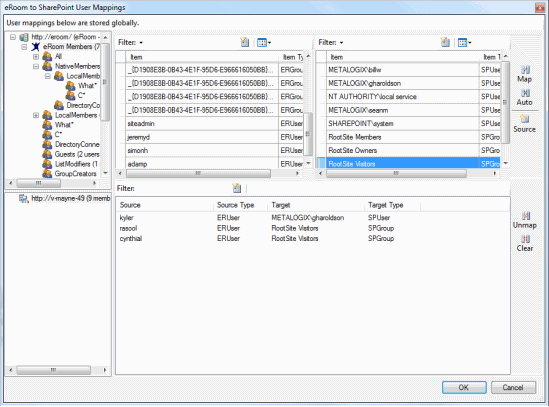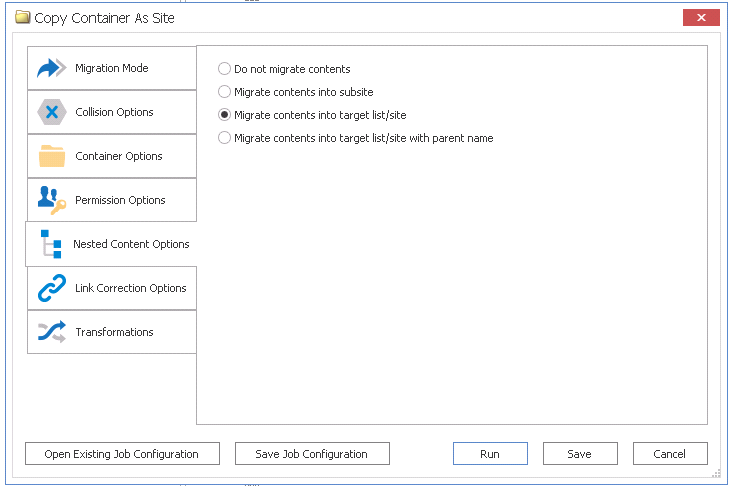Permissions Options
Users groups and permissions can be migrated from eRoom into SharePoint as part of a migration action. eRoom users and groups can be manually, and is some cases automatically, mapped to SharePoint users and groups, but permissions are automatically mapped using a special algorithm.
NOTE: Permissions options are available when migrating eRoom containers (not individual lists or items).
How eRoom Users and Permissions are Mapped to a SharePoint Target
Metalogix Content Matrix will will automatically try to map users from the eRoom source to the SharePoint target. This automatic mapping will only work in cases where the eRoom source has been configured to authenticate the user name format using Active Directory (AD), which is not a typical scenario. In all other cases, the eRoom users and groups must be mapped to users that already exist on the SharePoint target.
Metalogix Content Matrix can also use a special alogorithm try to migrate permissions by "best match" between eRoom and SharePoint permissions. A "match" is determined by comparing the explicit rights assigned to a user on the source and the rights that are included in roles on the target server.
For example, consider the scenario where "billw" has permission to read and edit a calendar in eRoom. During the migration of that calendar, eRoom Edition will analyze the available permissions on the SharePoint server and might find the Contribute role which allows view, add, update and delete permissions. If no other role is a better match, this role will be applied for the user mapped to "billw" on the migrated calendar.
Each eRoom room has four built-in principle types of permissions by default, and these four principles are a rough equivalent to the standard out-of-box SharePoint permission levels. A best practice method when migrating permissions would be to migrate them from the eRoom room level.
NOTE: These permission mappings are not set by default, and are only acting as basic guidelines.
|
eRoom Rights |
SharePoint Permissions |
|
Coordinators |
Full Control |
|
Custom Roles |
Design / Manage Hierarchy |
|
Participants |
Contribute |
|
Observers |
Read/Restricted Read/Limited Access |
To configure Permissions Options:
1.If you want to map source eRoom users to target SharePoint users, check the Map user metadata box.
If this box is not checked, or if the eRoom user does not have an equivalent user SharePoint user that it is mapped to (or if the name format does not match the format used in AD), the migrating account's information will be used instead.
2.Select the applicable sub-option(s). Use the information in the following table for guidance.
|
If you want to ... |
Then ... |
|
map eRoom users and groups to SharePoint users and groups |
Click the [Edit Mappings] button. Follow the procedure for Mapping Users. |
|
have Metalogix Content Matrix use an algorithm to a "best match" mapping of existing permissions between eRoom and SharePoint |
check the Migrate permissions by best-match box. NOTE: No new permission levels will be created on the SharePoint target. |
Mapping Users
You can set user and group mappings for migrating content when you click the [Edit Users] button from the Permissions Options tab.
Users can also be mapped as a separate action.
All user mappings are globally set, so once a mapping is created it will always be used unless removed.
NOTE: If the source eRoom environment has a large number of users/groups, it is recommended that the XML user mapping method be used instead, to help improve performance, and for better control over user mapping.
To map users:
NOTE: Metalogix Content Matrix supports many-to-one mappings between source and target.
1.In the top left pane, select the top level eRoom community or group that contains the users and groups that you want to map.
The source list becomes populated with all of the users and groups that exist under the selected node.
2.In the lower left pane, select the SharePoint site collection to which you want to map the users and groups.
The target list becomes populated with all of the users and groups that exist under the selected node.
3.Use the information in the following table to determine the appropriate action to take.
NOTE: You can Filter items in each window to narrow displayed lists.
|
If you want to ... |
Then... |
|
manually map individual users or groups on the source to a target SharePoint user or group |
·From the source list, select the Item(s) that you want to map. ·From the target list, select a target Item. ·Click the Map icon. |
|
have Metalogix Content Matrix automatically map source users/groups to target SharePoint users/groups |
·From the source list, select the Item(s) that you want to map. ·Click the Auto icon. NOTE: Metalogix Content Matrix will only map users automatically if the source and target side names match, or if the emails match, and the source and target environments are using the same AD. |
The mappings you create will display in the bottom window. (Note that you can also Unmap individually-selected mappings in the bottom window or or Clear all mappings from the bottom window.
4.Click [OK] once all desired mappings have been made and return to the Copy Options dialog.
Importing User Mappings from an xml File
Metalogix Content Matrix can import any desired user mappings from an XML file. Importing user mappings from an XML file involves creating an XML file with the desired mappings, then importing that file. This option is generally used if migrating from an eRoom environment that has a large number of users/groups.
To create a an xml file of user mapings:
Create a file, with any name, that contains any desired user mappings. The file can either be text based or an XML file, but must contain a root level node named Mappings, and have one child node for every mapping that you want imported. Each child node must contain two attributes: Source and Target. The Source is the Login Name of the source side user, and the Target attribute is the Login Name of the target user that is being mapped to.
The XML file should follow the below format:
<Mappings>
<Mapping Source="eRoomUser1" Target="Domain\User87" />
<Mapping Source="eRoomUser2" Target="Domain\User254" />
</Mappings>
NOTE: The Login Names used in the above example may vary depending on the authentication methods used by the source and target environments.
To import the XML file into Metalogix Content Matrix:
1.In Explorer View, select the top-level node of the eRoom connection .
2.Right-click and choose Import User Mappings to display the Import Users Mappings dialog.
3.Click Import From XML button, then navigate to and open the XML file you want to import.
The Import User Mappings dialog is populated with the mappings contained in the XML file.

Now you can:
§delete single mappings (by selecting the desired mapping, and clicking Delete)
§clear all mappings (by clicking Clear)
Any mappings that are listed in the Import Users Mappings dialog are not authenticated until the time of migration. Any spelling mistakes that exist will not be corrected. If a user mapping is not valid, or authenticated, the migration account will be used instead.
4.Click [Save] to continue and add the mappings.
Nested Content Options
Hierarchy structure is different between eRoom and SharePoint. eRoom hierarchy structure can become very complicated, because a list can have any number of sub-elements, including other lists, folders, or items. These sub-elements can also contain other lists, folders, items, and so on. This kind of potential behavior is called "nested content."
In SharePoint, however, only sites can contain other types of content (such as lists, calendars, document libraries, etc.). This can become an issue when migrating content that can exist in a nested structure to a different hierarchy structure. Metalogix Content Matrix has a set of Nested Content options that users can set when migrating their content. These options are available for most migration actions, and are found under the Nested Contents tab. The Nested Contents tab is available for the following actions:
To configure Nested Content Options:
Select how you would like to have nested content handled. Use the information in the following table for guidance.
|
If you want to ... |
Select ... |
|
prevent any nested content from being migrated to the target |
Do not migrate contents. |
|
migrate any nested content of a migrated item into a single subsite under the migration target (with all of the nested content flattened to a single level and placed under the subsite) |
Migrate contents into subsite. |
|
migrate any nested content into the target site or list, so that: ·If the target is a SharePoint site, or if the migration is creating a SharePoint site under the selected target location, all of the nested content would be flattened to a single level and placed under the selected target site ·If the target is a SharePoint list or library all of the nested content would again be flattened to a single level but would be placed under the parent site of the selected target SharePoint list/library. |
Migrate contents into target list/site. |
|
migrate any nested content into the target site or list in the same manner as the Migrate contents into target list/site option, but with the parent site or list name appended to the end of the nested content lists |
Migrate contents into target list/site with parent name. |



